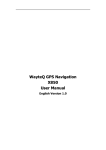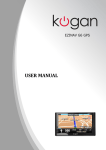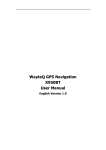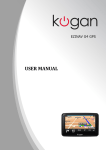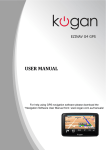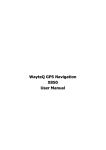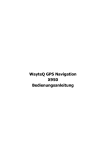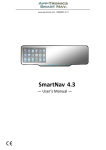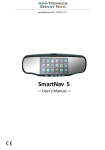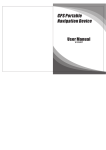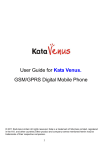Download MONGOOSE NOMAD User Manual
Transcript
MONGOOSE NOMAD Reversing camera monitor and GPS navigation User Manual Model : GPS43AVB O pe rati on Instruction Read Me First Thank you for choosing the Mongoose NOMAD GPS navigator and reversing monitor. The product, appearance or features are subject to change without notice. Please make a back up of any personal files or information that you may keep in the Nomad. Mongoose assumes no responsibility for any loss caused by material loss. Please read the instructions in this manual and use only accessories of Mongoose to avoid unpredicted damage. Failure to follow the instructions will invalidate warranty and might endanger personnel safety, for which Mongoose assumes no responsibility. Data of navigation electronic maps might be inconsistent with actual traffic signals due to transport and road development. Please follow traffic regulations and signs and drive according to road situation. Operating the Nomad device while driving might cause serious accidents. Mongoose assumes no responsibility for accidents and loss due to improper use. For information of software update and upgrade, please go to the website www.horizonnavigation.com The pictures in the manual are subject to copyright. Operation Instru cti on C on ten ts Welcome···················································································· 5 Chapter I Begi nning Use ································································································· Err or! Bookm ark not defined. 1.1 Appearance ·································································· 6 1.2 Power Supply & Charging ·············································· 7 1.3 Basic Use····································································· 8 1.4 System Main Screen and Major Functions ······················· 9 1.5 Reversing camera…………………………………………….. 10 Chapter II GPS ··········································································· 11 2.1 Map ············································································· 11 2.2 Navigation ···································································· 11 2.3 Reception ····································································· 11 Chapter III Media ········································································ 12 3.1 Music Player································································· 12 3.2 Video Player ································································· 18 3.3 Photo Browser ······························································ 20 3.4 E-book Reader······························································ 23 Chapter IV Bluetooth ··································································· 29 4.1 Pair·············································································· 29 4.2 Making a Call································································ 30 4.3 Answering a Call ··························································· 34 4.4 Dial Record··································································· 34 4.5 Redial ·········································································· 36 4.6 Setting ········································································· 36 4.7 Paired Device List ························································· 38 4.8 Search Bluetooth Device················································ 41 4.9 Phonebook ··································································· 42 Chapter V Games ······································································· 44 O pe rati on Instruction C on ten ts 5.1 Othello ········································································· 45 5.2 DuiDuiPeng ·································································· 45 5.3 Russia Block································································· 46 5.4 Lianliankan ··································································· 46 5.5 BoxMan········································································ 46 5.6 Gobang ········································································ 47 5.7 Snake ·········································································· 47 5.8 JawBreaker ·································································· 47 5.9 BreakOut······································································ 48 Chapter VI Tools ········································································· 49 6.1 Calculator ····································································· 49 6.2 Unit ·············································································· 50 Chapter VII Settings ···································································· 51 7.1 Summary······································································ 51 7.2 Volume········································································· 53 7.3 Backlight ······································································ 54 7.4 Language ····································································· 55 7.5 Date & Time·································································· 55 7.6 Calibration ···································································· 56 7.7 System Info ·································································· 57 7.8 USB ············································································· 58 7.9 Navigation Path ···························································· 60 7.10 Factory Reset ····························································· 61 Chapter VIII GPS Info·································································· 63 Chapter XI Troubleshooting ························································· 64 4 Wel come Welcome Thank you for choosing the Mongoose Nomad. A monitor for a reversing camera and GPS navigation are the major functions with other features being audio and video play, photo browsing, e-book reading and games. Friendly user screen for simple operation Power management for longer and more stable operation Data transmission with computers via Mini USB Quality reception for accurate positioning and navigation Safer reversing when connected to a camera You may use the Nomad anytime anywhere, for example while driving, walking or cycling. Its navi gation and amusement functions will provide you will both convenience and entertainment. To fully utilise the functions of MONGOOSE NOMAD and to understand the operation details, please read this manual carefully. www.mongoose.co.au www.mongoose.co.nz This manual is applicable only to the Mongoose NOMAD model: GPS43AVB. 5 Chapte r I Be gin nin g Use 1.1 Appearance SN Com ponent Explanation 1 Power key On/ off switch or enter sleep mode 2 Microphone Voice input for Bluetooth function 3 Indicator light Indicates the operating state of external power supply 4 Stylus slot Stylus inside 5 MINI Communicating with PC via MINI USB cable 6 USB port and used as the charging port Earphone Connects to the stereo headphones jack 7 AV-in port Connect a rear-view camera to this port 8 SD card slot SD card inside 9 Speaker Playing sounds (such as navigation prompt tones, music, etc.) 10 Reset key Press using the stylus to restart the system 6 Ch apter I Beginning Use 1.2 Power Supply & Charging Charge the Nomad fully with the charger before first use. 1.2.1 Power Supply The NOMAD can be powered by the built-in battery or external power supply. When the Nomad is not connected to the charger, it is powered by the Li-polymer battery. The battery capacity icon in the system main screen shows current residual battery capacity. When the Nomad is connected to the charger, it is powered by external power and the battery is charged. Note: The Nomad has an internal non-removable Li-polymer battery. To avoid battery rupture, explosion, release of hazardous substance or burn, do not unpack, pierce, strike on or discard the battery in fire or water. 1.2.2 Charging by Charger The Nomad must be charged with the charger before first use. Plug the USB terminal of the charger into the USB port on the left side of the unit and the other to the power socket to supply power and charge the Nomad. [Note] The charging indicator light is red during charging. Do not unplug the charge until the battery is fully charged and the indicator light turns green. Please charge when the battery is low or discharged. 1.2.3 Charging by Car Charger Plug one terminal of the car charger into the USB port on the left side of the Nomad and the other to the vehicle power socket. [Note] Plug in the car charger after the vehicle is started to avoid damage due to current surge. 7 Chapte r I Be gin nin g Use 1.3 Basic Use 1.3.1 Powering on/off & Sleep 2.3.1.1 Powering on Press the power key on the top side of the Nomad for at least two seconds to power it on. [Note] High humidity may lead to a short circuit of the Nomad. Power the navigator after it has acclimatised to a new environment. 2.3.1.2. Powering off & Sleep Press the power key for longer to turn the power off. The following screen will be prompted. If is selected, the navigator will automatically resume the state before entering sleep mode when powered on again. 1.3.2 Restarting the System When the system does not respond, press the reset key on the back of the unit to restart the system. [Note] The following situations might lead to no response of the system. 1. Delay or stagnancy in screen switching; 2. Failure of function acti vation with overlong execution; 3. Failure to power on/off the Nomad by pressing the power key Restarting the system by pressing the reset key will result in loss of unsaved data. Please backup your data regularly. 8 Ch apter I Beginning Use 1.3.3 Fixing the Nomad with Mounting Kit The mounting kit is composed of a back splint and a bracket. To use the Nomad i n a vehicle, fix it on the windscreen or other smooth surface. It will not adhere to textured surfaces. [Note] Do not place the Nomad in positions obstructing the driver’s vision. Do not place it without fixing it, or in front of an air bag or the area where an air bag may be inflated. 1.3.4 Using T-FLASH Card Insert the card in the corresponding slot. [Note] 1. Do not take out the T-FLASH card while a navigation program is being run or a media file is being played. 2. Avoid dropping the T-FLASH card, do not exert heavy pressure on it or bend it. 3. Avoid using or storing the T-FLASH card in high temperature, high humidity or direct sunlight. Keep the card away from liquid or corrosive substance. 4. Mind the direction while inserting the T-FLASH card to avoid damaging the slot or the card. 1.4 System Main Screen and Major Functions Press the power key on the top side of the Nomad and release after two seconds to power it on and enter the system main screen shown below. 9 Chapte r I Be gin nin g Use View the functions by pressing at the bottom right of the screen. Tap「GPS」,「Media」, 「Bluetooth」,「Games」,「Tools」,「Setting」 to enter the next function menus. The main functions are listed as below. Function Explanation GPS Tap to run the navigation software Music player .WMA9 and .WAV files supported; Random, sequence and cycle play supported Video player .WMV, .ASF and .AVI files supported; Adjustment of playing progress, pause and full-screen play supported Photo browser .JPG,.GIF,.BMP and .PNG files supported; Photo rotation, zoom in/out and auto play supported E-book .TXT fil es reading, page selection supported Bluetooth Enable wireless connection between the Nomad and a Blue-tooth mobile phone Games Othello, DuiDuiPeng, Russia Block, Lianliankan, BoxMan, Gobang, Snake, JawBreaker and BreakOut Tools Calculator and Unit Setting Set volume, backlight, language, date& time, FM Transmitter, USB mode and navigation path; view system info; screen calibration and factory reset Reversing camera (if connected) The reversing camera plugs into the A/V port. When the camera is powered by selecting the vehicles reverse gear, this input has priority over all other functions and the camera picture will appear. The screen will return to that previously selected when the camera switches off. 10 Chapte r II GPS Chapter II GPS Various navigation mappi ng applications can be installed in the Nomad, such as CARELAND and RITU intelligent navigation systems, which position the navigator via the satellite receiver and display it on the map. Set a destination, and the system will automatically work out the best path to help the user reach the destination safely and quickly. 2.1 Map Due to transportation development, inconformity between products and real traffic information will occur a period after product release. Please drive according to road condition and abide by traffic regulations. 2.2 Navigation Navigation paths are for reference only, and the user may decide whether to follow them. 2.3 Reception High and crowded structures (such as inside of tunnels, space between high buildings, underground car parks and under viaducts), weather change or satellite signals turnoff may influence signal reception, resulting in positioning failure, inaccurate positioning, navigation failure or system function abnormity. With stereoscopic maps, instant animation, voice prompt and text prompt of the navigation system, you will appreciate its unique charm and enjoy a great trip. Different navigation maps may have different operation methods. Please follow instructions of corresponding navigation mapping applications. 11 Ch apter III Media Chapter III Media The Media function includes the music player, video player, photo browser, e-book reader and Flash player. 3.1 Music Player This section introduces the usage of the music player. 3.1.1 Features The music player supports .WMA9 and .WAW files and selection of play sequence. Copy audio files to a folder in your memory card before using the player. 3.1.2 Screen and Operation Tap in the system main screen to enter the Media screen as shown below. 12 Ch apter III Media Tap Icon to enter the Music Play as shown below. Nam e Explanation Close Close the music player. Minimize Minimize the music player and return to the Media screen. Play Pause) (or Continue playing the paused/ stopped music or (Pause the music being played) 13 Chapte r III Me dia Icon Nam e Explanation Stop Stop the music being played. Set play Tap to set the play mode as mode -sequential, -cycle, -random, or -play single -repeat single. Previous Play the previous music. Next Play the next music. Volume Drag it leftward to turn down or rightward to turn up the volume. Progress Drag it leftward or rightward to play from a previ ous or future moment. Music list Enter it to select music to play. Time Display the run time. Equalizer Enter the equalizer. You may select Pop, Rock, Metal, Dance, Electronic, Country, Jazz, Oldies, Blues, Nostalgia, Opera or speech, or user define. 14 Ch apter III Media 3.1.3 Select and Play To play music, you need to add it to the from the Music Play. Tap in the screen Music Play to enter the Music list shown as below. Icon Nam e Explanation Close Close the Music List Scroll Drag it upward/ downward to view all music. bar Add one Add a piece of music on the left list to the play list on the right. 15 Chapte r III Me dia Icon Nam e Explanation Add all Add all the music on the left list to the play list on the right. Delete Select one piece of music in the play list and tap one the icon to delete it. Delete all Delete all the music in the play list. After adding music by following the instructions in the above table, double tap a piece of music in the play list to start playing from. 3.1.4 Lyrics Display If your memory card contains corresponding . lrc files for the music being played, then lyrics will be played at the right side of the Music Play screen. Double tap the lyrics area to view the lyrics in full screen as shown below. Under full screen mode, double tap the screen to return to normal-sized screen. 16 Ch apter III Media 3.1.5 Set the Equalizer In the Music Play screen, tap「 」to enter the equalizer as shown below. Tick in「 」on the upper left of the above screen, and then tap to select a music type or “User” from the drop-down menu. The music types include Pop, Rock, Metal, Dance, Electronic, Country, Jazz, Oldies, Blues, Nostalgia, Opera and speech. If “User” is selected, you may drag the slider at will to set the equalizer. After setting, tap 17 to Chapte r III Me dia save and return to the Music Play screen. 3.2 Video Player This section introduces the usage of the video player. 3.2.1 Features The video player supports WMV, ASF and AVI files, full-screen play, progress selection and file selection. Copy video files to a folder in your memory card before using the player. 3.2.2 Screen and Operation Tap in the Media screen to enter the video player screen shown as below. Icon Nam e Explanation Close Close the video pl ayer. Previous Play the previous film. film 18 Ch apter III Media Icon Nam e Explanation Play Continue playing the paused/ stopped music. Next film Play the next film. Stop Stop the film being played. Video Enter it to select a film to play. folder Progress Drag the sliding block leftward to play from a previous moment or rightward coming moment. Volume Drag it leftward to turn down or rightward to turn up the volume. Time Display the play time and the music duration. 3.2.3 Select and Play Tap in the video player screen to enter the video folder shown as below. Double tap on a vi deo file to start playing. 19 Chapte r III Me dia Icon Nam e Explanation Close Close the video folder. Scroll Drag the sliding block upward/ downward to view all bar the files inside the folder. 3.3 Photo Browser This section introduces the usage of the photo browser. 3.3.1 Features The photo browser supports JPG, GIF, BMP and PNG files, photo rotation, zoom in/ out and auto play. Copy photos to a folder in your memory card before using the browser. 20 Ch apter III Media 3.3.2 Screen and Operation Tap in the Media screen to enter the photo browser screen shown as below. Icon Nam e Explanation Previous View the preview photo in the folder. Next View the next photo in the folder. Zoom in Scale up current photo. Zoom Scale down current photo. out Rotate Rotate current photo 90°clockwise. Auto play Cycle play all the photos in the folder from current photo. Folder Enter the photo folder to select a photo. 21 Chapte r III Me dia Close Tap Close the browser and return to the Media screen. in the browser screen to enter the photo folder shown as below. Icon Nam e Explanation Close Close the current folder. Return Return to the previous folder. Scroll bar Drag the sliding block to view all the photos. Double tap the screen to view in full screen shown. 22 Ch apter III Media While slide show playing photos, tap the screen to display the playing speed as shown in the foll owing screen. Drag the slider to adjust the speed. 3.4 E-book Reader This section introduces the usage of the E-book reader. 3.4.1 Features The reader supports TXT files, page turn and folder selection. Copy TXT files to a folder in your memory card before using the browser. 3.4.2 Screen and Operation Tap in the Media screen to enter the reader screen shown as below. 23 Chapte r III Me dia Icon Nam e Explanation Close Close the reader. Scroll bar Drag the sliding block upward/ downward to vi ew all content of the e-book. Folder Enter the e-book fol der to select an e-book to read. Previous Read the previous page. Next Read the next page. Setting Select a text theme, font, word size and bold type. New Select partial text and tap the icon to create bookmark a bookmark. 24 Ch apter III Media Icon Nam e Explanation Bookmark list Enter the bookmark list to select or delete a bookmark. Page/ total Current page/ total pages pages 3.4.2 Setting Tap in the e-book reader screen to enter the setting screen shown as below. Icon Nam e Explanation Close Exit the setting screen Save Save the setting. 25 Chapte r III Me dia Icon Nam e Explanation Theme Tap to select a theme for the e-book. Tap to select a font for the e-book. Font Bold Tap to enable bold type. Tap it again to cancel. 3.4.2 Read a Text Tap in the e-book reader screen to enter the e-book folder shown as below. Icon Nam e Explanation Close Close current folder. 26 Ch apter III Media Icon Nam e Explanation Return Return to the previous folder. Scroll Drag the sliding block upward/ downward to vi ew bar all TXT fil es. 3.4.2 Create a Bookmark To create a bookmark, locate a page by taping or or dragging the scroll bar in the reader screen and drag to select text content. Tap Tap when it is on. Tap OK to finish. to view created bookmarks in the screen of Bookm ark List shown as below. 27 Chapte r III Me dia Drag the scroll bar and select a bookmark on the left list. Tap go to the page with the bookmark or tap bookmark. 28 to to delete the Ch apter IV Blue tooth Chapter IV Bluetooth This function realizes wireless connection between the Nomad and a Bluetooth mobile phone for making and answering calls. Before using this function, make sure that Bluetooth function of the cell phone has been enabled. Tap「Bluetooth」icon on the to enter the Bluetooth screen shown as below. To quit the screen, tap . 4.1 Pair Pair the navigator and a mobile phone while setting up connection 29 Chapte r IV Bluetooth between them for the first time . Tap in the Bluetooth screen to enter the following screen. Meanwhile, press the icon “Search audio device” or similar one on the mobile phone. After the mobile phone finds and display the name of the navigator (i.e. PND), tap “Connect” and input the default PIN code: 8888. After pairing, the following screen will be displayed with connection situation and mobile phone name on the bottom. 4.2 Making a Call Tap on the Bluetooth screen to enter the keypad screen as shown below. 30 Ch apter IV Blue tooth Icon Nam e Explanation Backspace Delete the last input number or sign Dial Dial the input number Call Check the answered call records, outgoing records call records and missed call records To make a call, input the number to call and tap below. 31 as shown Chapte r IV Bluetooth Icon Nam e Explanation Volume down Reduce the volume Volume up Increase the volume Hang off End the call After the call is put through, the following screen will be displayed. Icon Nam e Explanation Volume Reduce the volume down Volume up Increase the volume 32 Ch apter IV Blue tooth Icon Nam e Explanation Keypad Open the keypad as shown in the following screen Microphone Tap to stop audio input, and tap it again to resume audio input. Voice Tap to switch the voice from the navi gator to switch the mobile phone; to switch the voice back to the navigator, you may tap the “hands free” or similar icon on the mobile phone. Hang off Hang off the call To input numbers or other content during a call, tap in the above screen to display the keypad as shown below. To hide the keypad, tap the icon again. 33 Chapte r IV Bluetooth 4.3 Answering a Call When there is a incoming call, the following screen will be displayed. Icon Nam e Explanation Volume down Reduce the volume Volume up Increase the volume Answer Answer the call Reject Reject the incoming call 4.4 Dial Record Tap in the Bluetooth screen to enter the call records screen as shown below. 34 Ch apter IV Blue tooth Icon Nam e Explanation Incoming call Tap it to view the list of incoming call records numbers. Outgoing call Tap it to view the list of called numbers. records Failed call Tap it t to view the list of failed calls. records Generate Select a number in the list and tap this icon to generate a call. Delete one Select a number in the list and tap this icon to delete it. Delete all Select all the numbers in the list and tap this icon to delete it. 35 Chapte r IV Bluetooth 4.5 Redial Tap in the Bluetooth screen to redial the latest dialed number and display the call screen. Refer to 5.2 Making a Call for detailed operation. 4.6 Setting Tap in the Bluetooth screen to enter the setting screen as shown below. Icon Nam e Explanation Name The device’s display name in the Bluetooth transmission process. 36 Ch apter IV Blue tooth Icon Nam e Explanation Pin code Tap to set a pin code for the connection between the PND and mobile phone. Ring Tap / to select a ring tone. (Optional) If this item is selected, Bluetooth function remains enabled when the Bluetooth screen is closed. Otherwise, Bluetooth function will be disabled. (Optional) If this item is selected, the system will generate auto hands-free profile between the navi gator and the mobile phone when Bluetooth is restarted. 4.6.1 Modify Bluetooth Pin Code To modify the Bluetooth PIN code, tap enter the following screen. 37 in the above screen to Chapte r IV Bluetooth Input a new PIN code, tap tap to return to the setting screen and to finish. To cancel the modification, tap to return to the setting screen and tap it again to quit. 4.7 Paired Device List In the Bluetooth screen, tap to enter the Paired Device List screen as shown below. 38 Ch apter IV Blue tooth Icon Nam e Explanation Profile list Select a paired device from the list on the left and tap this icon to view the profile list as shown in the following screen. Delete one Select a paired device and tap this icon to delete the device. Disconnect Select a paired device and tap this icon to disconnect the navi gator from the device. 4.7.1 Profile List Select a paired device and tap to view the profile list of this device as shown below. [Note]: Profile details may differ for different mobile phone. 4.7.1.1 HFP Select a service from the Profile List and tap the highlighted icon on the right. If the navigator is in connection with the mobile phone, tap “Hand 39 Chapte r IV Bluetooth free service” and then to disconnect; if the navigator is not connected with the mobile phone, tap for connection. 4.7.1.2 Dial-Up Network Service Select DUN service and then tap to enter the DUN screen as shown below. Icon Nam e Explanation Service provider Tap name to select your service provider. Service provider Tap to add, modify or information delete the information of the selected service provider. 40 Ch apter IV Blue tooth Icon Nam e Explanation Connect to Tap to establish DUN network connection. After connection, you may enter the WINCE screen to use Internet Explorer for web browsing and downloading. 4.8 Search Bluetooth Device Tap in the Bluetooth screen to enter the Search Bluetooth Device screen for auto Bluetooth device search and display as shown below. 41 Chapte r IV Bluetooth Icon Nam e Explanation Stop Stop searching for Bluetooth devices. Pair After selecting a Bluetooth device, tap the icon to pair the navigator and the mobile phone. The default PIN code “8888” Shall be input. After connection, the Profile List of the device will be displayed. Refer to 5.7 Pair Device List. Pair device Tap to enter the Pair device list. list Refer to 5.7 Pair Device List. 4.9 Phonebook Tap in the Bluetooth screen to enter the Phonebook screen as shown below. 42 Ch apter IV Blue tooth Icon Nam e Explanation Download Download the phonebook of the mobile phone to the PND. Dial Select a number from the phonebook and tap this icon to generate a call. Delete Select a number from the phonebook and tap this icon to delete it. 43 Chapte r V Games Chapter V Games This chapter introduces the usage of Games. Tap in the system main screen to enter the Games screen as shown as below. Tap Tap to exit. to go to the next page. 44 Chapte r V Games 5.1 Othello Tap in the Games screen to enter the screen as shown below. 5.2 DuiDuiPeng 45 Chapte r V Games 5.3 Russia Block 5.4 Lianliankan 5.5 BoxMan 46 Chapte r V Games 5.6 Gobang 5.7 Snake 5.8 JawBreaker 47 Chapte r V Games 5.9 BreakOut 48 Chapte r VI Tools Chapter VI Tools The tools include Calculator and Unit conversion. Tap in the system main screen to enter the tools screen as shown below. Tap to exit. 6.1 Calculator Tap in the Tools screen to enter the calculator screen as shown below. 49 Chapte r VI Tools 6.2 Unit Tap in the Tools screen to enter the unit converter screen as shown below. 50 Chapte r VII Settin gs Chapter VII Settings 7.1 Summary This chapter introduces the system settings of the Nomad. Tap in the system main screen to enter the system screen to set volume, backlight, language, date& time, FM Transmitter, USB mode and navi gation path; view system info; screen calibration and factory reset. Tap to display the next screen. 51 Chapte r VII Settin gs Function Explanation Volume Adjust the speaker volume; Open/ close the startup music setting Backlight Adjust the brightness of touch screen backlight; Latency of auto backlight turnoff under power supply. Language System language selection Date & time System date setting; System time setting; System time zone setting; Calibration If deviation occurs while touching the screen , calibrate the screen. System info Display system information including ROM version, software version, OEM version, platform ID and device ID. FM Transmit audio signals of the navigator to radio sets. transmitter USB setting Data transmission mode between the navigator and PC. Navigation Select a document path for the navi gator. path 52 Chapte r VII Settin gs Factory Reset the factory default settings. Reset 7.2 Volume Tap in the system screen to enter the volume setting screen as shown below. Icon Nam e Explanation Save Save the setting. Close Exit the volume setting. Volume Ten volume grades (from mute to maximum) available. Tap to decrease the volume by grade. Sounds for Tap it to enable the function. taps Tap it again to disable the function. 53 Chapte r VII Settin gs Power-on Tap music power-on music or disable it. or to select 7.3 Backlight Backlight setting includes backlight brightness adjustment and latency of backlight off. Tap in the system screen to enter the backlight setting screen as shown below. Icon Name Explanation Save Save the setting. Close Exit the backlight setting. Backlight Drag leftward to turn down or rightward backlight. 54 to turn up the Chapte r VII Settin gs Icon Name Explanation Auto off Auto backlight shutoff after service stop for a period. The options are always On, 10s, 30s, 1m, 2m and 3m. Tap or to view the options in cycle or select one. 7.4 Language Tap to enter in the system screen to enter the language setting screen as shown below. Tap and tap or to select a system language to save the selection. 7.5 Date& Time Tap to enter in the setting screen to enter the language setting 55 Chapte r VII Settin gs screen as shown below. Date & Time setting includes system date setting, time setting and time zone setting. 7.5.1 Setting the system date and time In the above screen, tap or to set the year, month, day, hour and minute. [Note]: Time format options are 12-hour and 24-hour. 7.5.2 Setting the system time zone In the above screen, tap or to select a time zone. For example, select “(GMT+08:00) Beijing, Chongqing, Hong Kong, Urumqi” for China. 7.6 Calibration Tap in the setting screen to prompt the calibration dialo g shown as below. 56 Chapte r VII Settin gs Tap OK to execute calibration or Cancel to cancel calibration and go back to the setting screen. Tap OK, and the following calibration screen is prompted. Click the center of cross cursor with the stylus and the cursor shifts from the center, upper left, lower left, upper right and lower right to finish the calibration and the screen will be closed automatically to go back to the setting screen. 7.7 System Info Tap in the setting screen to view the system information screen as shown below. 57 Chapte r VII Settin gs 7.8 USB Connect the Nomad to PC via the MINI USB port to transmit data, or back up data from the navigator data to PC. The Nomad provides MASS STORAGE and MS STORAGE modes. Select one in the USB setting. 7.8.1 MASS STORAGE 1. Have the Nomad in operation status and the S D card plugged in the slot; 2. Tap in the system screen to enter USB Option as shown below. 58 Chapte r VII Settin gs Select MASS STORAGE and tap to save it. 3. Connect the MINI USB terminal of the USB cord to the MINI USB port of the Nomad and the standard USB terminal to the USB Host port of PC. Then, the navigator stop the current program and prompt the following screen. 5. After communication, unplug the MINI USB cable. 7.8.2 MS ACTIVESYNC 1. Tap in the system screen to enter USB Option as shown below. 59 Chapte r VII Settin gs Select MASS ACTIVESYNC and tap to save the setting. 2. Install the application Mobile Device in a drive of PC. Then the following icon will appear in the dri ve selection. 3. Connect the MINI USB terminal of the USB cable to the MINI USB port of the Nomad and the standard USB terminal to the USB Host port of PC. 4. After the PC finds new hardware, double click the Mobile Device drive in the selection area to enter the memory of Nomad for data transmission. 5. After transmission, unplug the USB cable. [Attention] For data safety back up the navigator data [Note] If MASS STORAGE is selected while the Nomad is connected with PC, other operations will be suspended. [Attention] The following operations will stop suspend the communication of the system and PC and unsaved data will be lost. 1. Unplugging the MINI USB cable; 2. Powering off the Nomad; 3. Resetting the system; 4. Tap the on close button on the top right. 7.9 Navigation Path Insert a T-flash card with map data into the Nomad and tap enter the screen shown as below. 60 to Chapte r VII Settin gs Select a map address and tap to save the setting. Tap to select a map address. Tick in the box to run the set navigation map when the navigator is powered on. 7.10 Factory Reset Tap in the system screen to restore the factory setting. The following dialog will be prompted. 61 Chapte r VII Settin gs Tap OK to restore the default setting or Cancel to return to the setting screen. 62 Chapte r VIII GPS In fo Chapter VIII GPS Info Tap on the system main screen to view the GPS information as shown below. Tap to prompt a dialog as below. Tap OK to reset the GPS satellite or tap Cancel to exit. 63 Chapter XI Troubleshootin g Chapter XI Troubleshooting Please carry out the following operations in case of abnormal operation of the Nomad. For further problems, please contact our customer service center. Fault Startup failure Reason Solution Low battery Supply external power and charge the battery. System down Reset the Nomad. Sudden power cut Low battery Supply external power and charge the battery. No/ vague display Low backlight Turn up the backlight. Backlight off Tap the screen with the touch pan. Touch screen not calibrated Recalibrate the screen. Low volume Turn up the volume. Poor contact of earphone Connect the earphone. Communication with PC Poor USB connection Connect the USB cable. GPS signals reception failure Poor signal About 3 minutes are needed for low intensity of local GPS satellite signal. Loss of map data Accidental deletion Incorrect response tapping No sounds GPS Contact your agent or distributor. Input a new password after recovering the GPS data. Note: This docu ment is for guidance only and the content is subject to change without notice. 64
































































